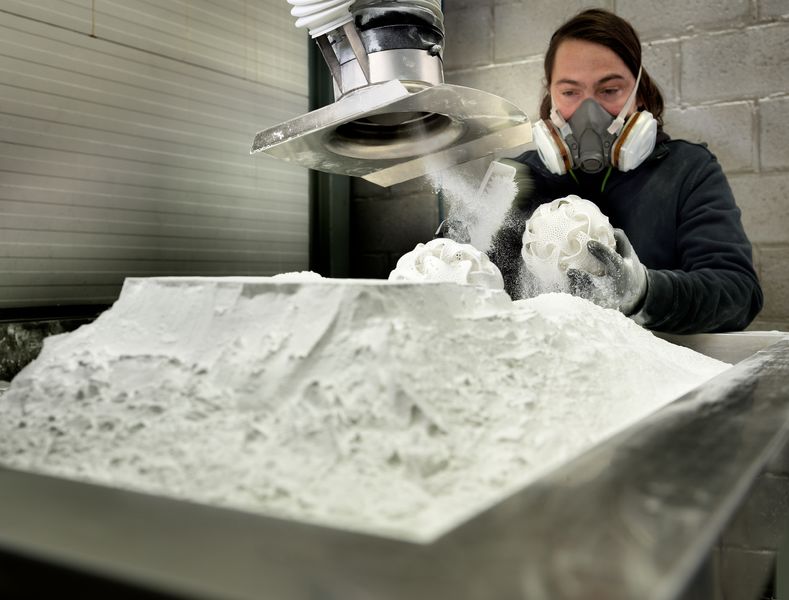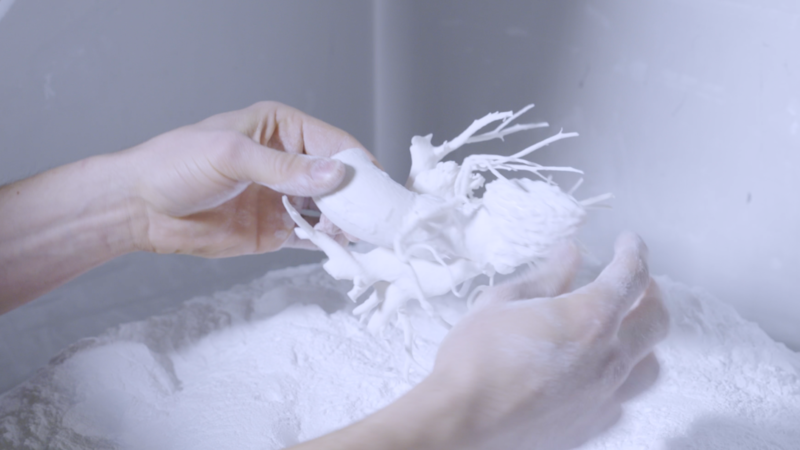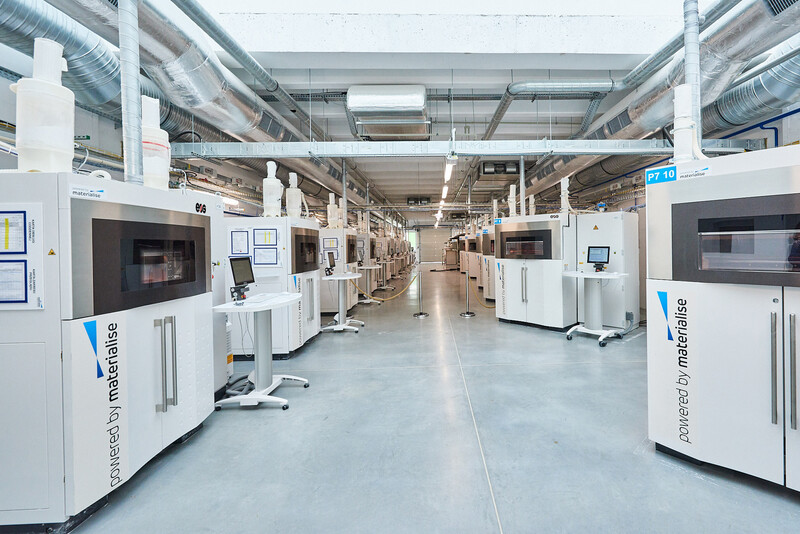Even though we in the 3D printing industry often tout our technology’s environmental benefits, we do produce waste. In the case of powder bed fusion (PBF), we produce a lot of it. In PBF, a laser sinters a powder, turning it into a part. Unsintered powder remains behind and supports the part and design features such as overhangs. When a block of powder is taken out parts, are exhumed and cleaned, the remaining powder is then sieved and recycled.

This can not be done infinitely, however, because as the powder is reused, it degrades and part properties suffer. Utilization and recycling rates vary depending on parts, material, and additives, but generally, we are estimated to throw away half of all sintering powder. Mostly PA 12. This engineering plastic is a high-cost material when used for laser sintering (PBF) costing anywhere from $30 to $95 a kilo. This means that, globally, hundreds of millions of dollars of powder are thrown away annually.

Belgian software to services company Materialise has announced a solution: Bluesint. With the Bluesint process, the company has cleverly tweaked a dual laser powder bed fusion system to heat recycled powder before building it into new parts. The company claims that, with this process, they can achieve a 100% recycling rate. This will save Materialise itself millions a year in powder that it can now repurpose into parts. If the company somehow shares this technology with others, it will be a boost for other services. Meanwhile, if it keeps it to itself, it will be a considerable advantage.
At the same time, Bluesint can really make 3D printing a very green technology with its 100% powder utilization rate. What’s more, the company says that, “Parts printed with Bluesint PA12 have similar mechanical properties, allowing users to make a choice not only based on technical specifications but also on the environmental impact.”

Materialise CEO Fried Vancraen, noted of the development:
“Many people view 3D printing as a positive force that helps companies to operate more sustainably. However, that’s simply not enough. As we enter the fourth decade of 3D printing, the question is not whether 3D printing is a sustainable manufacturing technology. The question becomes: what can we do to make 3D printing more sustainable?”
Jurgen Laudus, VP and General Manager of Materialise Manufacturing, added:
“With Bluesint PA12 we are able to significantly reduce powder waste. Bluesint PA12 represents a major step towards making 3D printing more sustainable and is an example of how we empower our customers to make a choice for sustainability.”
The company describes their innovation, saying:
“By using a 3D printer with multiple lasers, Materialise engineers were able to use one laser for sintering the powder and a second laser to keep the powder above a certain temperature threshold. By preventing the powder from cooling down between two layers, they prevented the shrinking process that causes the orange peel effect. The result is a printed object with similar mechanical and visual properties but printed with 100% recycled powder, drastically reducing waste.”
And says that, “Over the course of 2021, Materialise plans to have several Laser Sintering machines running Bluesint PA12. In the start-up phase alone the company aims to re-use more than five tons of powder that would normally become waste.”
Expressed as dollars, this means that they have an extra $300,000 of powder that they’ve just saved. This is a great move by Materialise that is a rare example of sane, green thinking that is not just “good for good,” but good for good and your wallet. Rather than a greenwash or a cuddly project to seek attention, the firm has fundamentally changed the economics PBF and PA 12 consumption in the industry. It is just this kind of thing that will make others see that going green is not just a marketing exercise, but can also give your firm real advantage with competitors.
By being the greenest manufacturing technology, we can, as an industry, really win new customers, verticals, and applications. There was a time when it was all about us being trendy. Instead, this kind of development is about us being useful, appropriate, and cost-effective. Material cost in 3D printing is too high and, here, we’ve seen a firm perform a drastic reduction in this cost that also gives them true environmental credibility and advantage.
It will be interesting to see what other firms in the industry will do in order to counter this move. Will materials companies ignore this development? Or will we see more examples of recycled and highly recyclable materials emerge? Is this just one company performing an advantageous strategy for them or is this the future of polymer manufacturing? I truly hope it is the latter because this kind of a technological improvement really is a solid demonstrable reason for an environmentally-conscious customer to choose 3D printing over alternative technologies.
Subscribe to Our Email Newsletter
Stay up-to-date on all the latest news from the 3D printing industry and receive information and offers from third party vendors.
You May Also Like
3D Printing News Unpeeled: A $3000 SLS System, Construction Subsidies and Parameters
The Housing Affordability Crisis is one of Canadian President Trudeau’s biggest issues. Now the government has made subsidies available, including scaling new technologies, 3D printed housing and libraries of reapproved...
“Bundled Light” Enables High Quality Plastic 3D Printing from LEAM
Naturally, we expect current 3D printing methods to continuously improve, but it continues to do so in the most surprising ways. The latest development comes from LEAM, a startup spun...
Each to Their Own: Exploring Creality’s Latest Ender Trio as the Company Strengthens Its Commitment to 3D Printing Advocacy
Creality has reaffirmed its commitment to promoting 3D printing. The launch of the Ender-3 V3 SE, Ender-3 V3 KE, and Ender-3 V3 showcases the company’s dedication to catering to diverse...
3D Printing News Briefs, March 23, 2024: AM in the US Coast Guard, Navy, & More
In today’s 3D Printing News Briefs, we’re discussing the use of 3D printing in various branches of the military, including the U.S. Coast Guard, the U.S. Navy, and the German...































